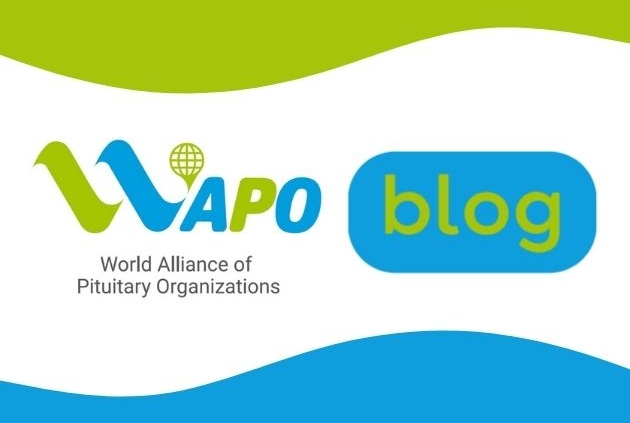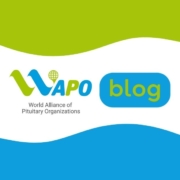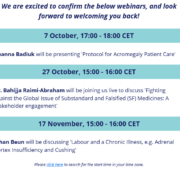Why patient organizations are vital to both patients and healthcare professionals
“Guest post by Natasha Barr – Caretently Health Communications, upon invitation by WAPO”
Being diagnosed with a pituitary disorder has a huge impact on a person’s life. The fact that many pituitary disorders are equally rare diseases only adds to the feeling of isolation that many patients may experience. Patient organizations aim to break that isolation by providing invaluable support, however, their role goes far beyond this one mission. Patient organizations provide a variety of valuable services to both patients and healthcare professionals and play a significant role in improving patient management and care.
This article covers the importance of patient organizations and the patient advocates that represent them.
Pituitary disorders are a group of disorders affecting the pituitary gland. This “master gland”, located at the base of the brain, makes important hormones that act on other glands and play a role in many vital functions such as growth, development, sexual maturation, reproduction, blood pressure control and metabolism. Pituitary disorders can have many causes (most commonly benign tumors) but they result in patients making too much or too little of these various hormones, leading to a large variety of symptoms and requiring multidisciplinary lifelong care. A patient organization is therefore a valuable partner to patients throughout their patient journey.
Patient organizations are first and foremost for the patients and their carers. The European Medicine’s Agency defines them as “not-for-profit organizations which are patient focused, and where patients and/or carers (the latter when patients are unable to represent themselves) represent a majority of members in governing bodies”. With that now clarified, let’s take a look at how these passionate patient advocate groups make a difference.
Many patient organizations offer dedicated support groups. Whether they are in person (e.g. via local meet-ups) or online (e.g. via Facebook groups), they are a much needed safe space for patients looking for information, guidance and support. Speaking and connecting with others living with the same condition is highly beneficial to patients and their families. These groups can lead to new friendships and give patients a much needed feeling of community. An example is the Ireland Pituitary Support group on Facebook, which has over 300 active members. Keep in mind that when it comes to Facebook groups, it is always a good idea to check if the group is moderated by a member of a recognized patient organization. This ensures that a set of community rules will be enforced and no misinformation will be shared.

Another role of patient organizations is one of raising awareness. As pituitary diseases are relatively unknown and can often present with non-specific symptoms, patients may wait years before receiving an accurate diagnosis. This delay in diagnosis leads to a delay in treatment and an increased risk of complications and a decreased quality of life. Patient organizations try to raise awareness for their rare disease(s) so that the medical community and the general public are more aware of the symptoms and warning signs. Awareness days, where information is shared on social media accounts, or public outreach campaigns, which aim to reach the masses and spread knowledge are both actions initiated by patient groups. Some great examples from the pituitary disease community include Acromegaly Awareness Day on November 1st and Cushing’s Awareness Day on April 8th.
Patient organizations produce educational resources on the diseases they cover that are scientifically validated by medical experts. If you type the name of a disease in Google, anything can pop up! This can lead to unnecessary distress and confusion. However, resources produced by a recognized patient organization can be trusted. They usually have a medical advisory board or collaborate with medical experts in order to produce accurate and comprehensive information on a given health topic. This information is also presented in a language that is easy to understand (i.e layman’s terms) and in the local language. WAPO, for example, has produced webinars on a variety of topics including depression in the pituitary patient, pain and stress in pituitary diseases and many more, which can be found in the WAPO library. There is also educational information on the various types of pituitary disorders on the website.
In addition to what they bring to the lives of patients, patient organizations collaborate with and help healthcare professionals.
Patient organizations can provide healthcare professionals with a roadmap for how to engage with patients in order to improve patient-clinician relations. They bring both the patients’ and their carers’ perspective to the table and provide insights that clinicians may not automatically consider. They may offer helpful suggestions, such as encouraging the patient to bring a family member or friend with them into the consultation. This allows for patients to have someone else listening and noting down the important facts given by the doctor, as one can often feel overwhelmed and forget what was said during the initial consultations. They stress the importance of showing empathy and truly listening to the patients and their needs. These tips can lead to a more trusting relationship between patients and clinicians.

They can also provide healthcare professionals with educational material for their patients. As mentioned above, the informative resources produced by the patient organization and validated by the healthcare professionals can be used directly by the healthcare provider. They can then be given to patients at the time of diagnosis so that they have written information to take home with them. They can provide expert centers with posters for their waiting area or flyers which can be given to patients at the end of their consultations.
Having a patient organization for a disease or group of diseases allows clinicians to refer their patients to these groups for support along their patient journey. Knowing that a patient organization exists for their disease reassures the patient that they are not alone. The patient organization can ensure that all of their questions are answered once they have had time to digest everything. Having a full understanding of the disease makes a patient more likely to adhere to a treatment protocol and to recognize signs of any life-threatening complications.
They can equally support research by informing patients of new research studies or clinical trials and by helping healthcare professionals find enough patients to participate in these studies. As the majority of pituitary disorders are rare diseases, research is often limited by insufficient patient numbers. By finding and reaching out to new patients, patient organizations can keep them up to date of new studies and clinical trials so that they can participate if they wish. They may even provide research grants to teams investigating new therapies for their disease. Setting up registries with healthcare professionals so that patients can be found for research purposes is another possible activity. Patient advocates are equally solicited during the development process of new treatments. One thing is for sure: without the participation of patient groups, research cannot advance.
Patient organizations partner with clinicians when creating Patient Reported Outcome Measures (PROMs), which are a set of measures used to assess care delivery and treatment efficacy. These measures should reflect the patients’ desired outcomes, so it is vital to have them involved. This was the case when the PROMs for patients undergoing transsphenoidal surgery for a pituitary adenoma were created. They were developed with the input of patient advocates from the Pituitary Foundation.
An equally important activity is strengthening the relationships between patient advocates and healthcare professionals via meetings or congresses. Healthcare professionals can share their latest research and patient advocates can ask the burning questions of the patient community they represent. Patient organizations often organize these types of multi-stakeholder meetings, which are highly beneficial to all that attend. The upcoming WAPO Global Summit 2023, which will take place in Buenos Aires, Argentina from October 6-8th, 2023, is a prime example of an event that allows for patient advocates from member organizations to come together and share best practices while also learning about the latest medical developments by top experts in the field of pituitary disorders.

Finally, let’s not forget that patient advocacy efforts are at the root of social change in the healthcare system. Patient organizations have an active role in driving change. Some great examples in the field of rare diseases include the various national rare disease plans (such as the national plan for rare diseases, or PNMR, in France which was created in 2004 and which has been renewed twice since), the launch of the European Reference Networks (and their European Patient Advocacy Groups or ePAGs) in 2017 and the first UN Resolution on Addressing the Challenges of Persons Living with a Rare Disease and their Families, which was passed in 2021. All are a direct result of the active participation of patient organizations and alliances fighting to improve the lives of rare disease patients.
So let’s remember all the valuable work that patient organizations and their patient advocates do every day. If you can, show them your support through volunteering, donating or sharing the news about their activities. They give their valuable time to support others in addition to dealing with their own chronic disease and its daily challenges. Together with healthcare professionals and all other stakeholders, patient organizations work to support and educate, eliminate barriers to care, promote health equity, and drive systemic changes that benefit all of society.
To see a list of WAPO’s member organizations, take a look at our member page here: https://www.wapo.org/overview-of-member-organizations/
Sources:
Cortial L, Nguyen C, Julkowska D, Cocqueel-Tiran F, Moliner AM, Blin O, Trentesaux V. Managing rare diseases: examples of national approaches in Europe, North America and East Asia. Rare Disease and Orphan Drugs Journal. 2022; 1(2): 10. http://dx.doi.org/10.20517/rdodj.2022.02 https://rdodjournal.com/article/view/4893
Karvandi, Elika et al. “A patient-reported outcome measure for patients with pituitary adenoma undergoing transsphenoidal surgery.” Pituitary vol. 25,4 (2022): 673-683. doi:10.1007/s11102-022-01251-x https://www.ncbi.nlm.nih.gov/pmc/articles/PMC9345822/
Ireland Pituitary Support: www.pituitaryireland.ie
https://www.eurordis.org/our-priorities/european-reference-networks/epag/






